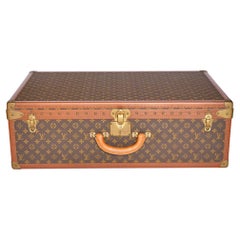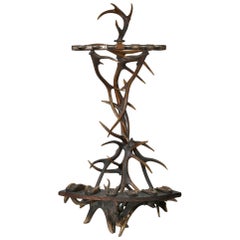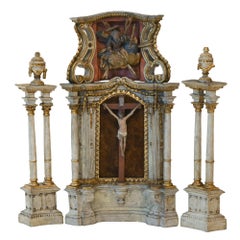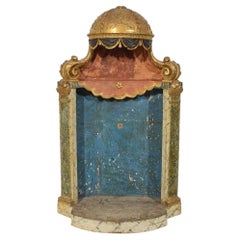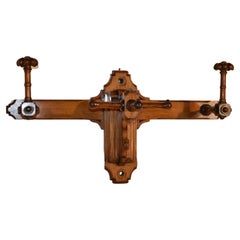Brigitte Martini Kunsthandel More Furniture and Collectibles
to
3
3
1
1
1
1
1
1
1
1
1
3
1
1
1
3
3
3
1
20th Century Louis Vuitton Suitcase Alzer 80, 1970
By Louis Vuitton
Located in Epfach, DE
909481 Alzer 80 80 cm x 26 cm 52.5 cm with removable tray
Louis Vuitton suitcase, Alzer 80 with removable tray, in wonderful, well-kept condition with origin...
Category
20th Century French Trunks and Luggage
Materials
Leather
19th Century, European, Antler Gun Rack and Stand, Brown, Wood
Located in Epfach, DE
19th century, European, Antler gun rack and stand, brown, wood
Antler gun rack worked out for six rifles
Probably Bohemia or Bavaria
The use of a...
Category
Antique Early 19th Century Czech Magazine Racks and Stands
Materials
Antler
18th Century Altar Modell, South Germany, with Original Painting, Wood
Located in Epfach, DE
18th century Altar Modell, South Germany, with original painting, wood
A rare altar model with original painting, in the middle Jesus Christus and on the ...
Category
Antique Late 18th Century German Louis XVI Models and Miniatures
Materials
Wood
Related Items
Italian 18th Century Neoclassical Carved Wooden Altar Shrine
Located in Buisson, FR
Beautiful neoclassical altar shrine with original gilding and color. Great and unique item.
Italy, circa 1760-1800
Weathered, losses and old repairs.
More photo's available on reques...
Category
Antique Late 18th Century Italian Neoclassical Religious Items
Materials
Wood
$3,270 Sale Price
50% Off
H 35.44 in W 20.48 in D 11.82 in
19th Century English Oak Coat and Hat Rack
Located in High Point, NC
19th century oak coat and hat rack from England. The piece attaches to the wall, and is handsomely turned and shaped for added design detail to any small space. The back is shaped ...
Category
Antique 19th Century English Victorian Hat Racks and Stands
Materials
Oak
18th Century Altar Console in Painted Wood from Portugal
Located in Round Top, TX
A very stunning Portuguese 18th century Altar console in painted wood and gilt accents. Beautifully sculpted form resting on a faux marble painted base.
Category
Antique Mid-18th Century Portuguese Console Tables
Materials
Wood
Antique LOUIS VUITTON Leather Hardcase Suitcase – Early 20th Century
By Louis Vuitton
Located in Victoria, BC
A distinguished piece of travel history, this antique Louis Vuitton hardcase suitcase is a fine example of the craftsmanship that defined luxury travel in the early 20th century. Con...
Category
Early 20th Century French Trunks and Luggage
Materials
Leather
18th/19th Century Spanish Colonial Carved Painted Wooden Santo Altar Figure
Located in Forney, TX
A lovely antique Spanish Colonial hand carved and painted wood santo altar figure - religious folk art sculpture.
18th/19th century, possibly earlier, most likely depicting Saint F...
Category
Antique 18th Century Spanish Colonial Religious Items
Materials
Wood
$750
H 10 in W 4 in D 4.25 in
18th Century Processional Painted Sunburst on a Baroque Silver Gilt Altar Vase
Located in Hastings, GB
A rare and exquisite 18th century iron processional sunburst with a painted central image of Holy Mother Mary presenting the rosary to Saint Dominic to one side and Ave Maria to the ...
Category
Antique Late 18th Century Italian Baroque Religious Items
Materials
Iron
$2,049
H 20.67 in W 8.08 in D 4.73 in
18th Century German Silver Festival Kiddush Goblet
Located in New York, NY
Silver Kiddush Goblet, Hieronymus Mittnacht, Augsburg, Germany, 1763-1765.
Classic style tulip-form bowl with chased scalloped design motif with facete...
Category
Antique 1760s German Religious Items
Materials
Silver
20th Century Louis Vuitton Suitcase Classic Monogram Canvas 60s
By Louis Vuitton
Located in Turin, Turin
Timeless suitcase by Louis Vuitton from the 60s with rounded edges and a double zipper. It is easy to carry with its comfortable rounded handles and bears a removable ID holder. It i...
Category
Vintage 1960s French Modern Trunks and Luggage
Materials
Leather
$4,757
H 13.78 in W 21.26 in D 7.49 in
20th Century Louis Vuitton Suitcase In Monogram Canvas, France c.1970
By Louis Vuitton
Located in Royal Tunbridge Wells, Kent
A charming Louis Vuitton hard-sided case, mid to late 20th century, the exterior finished in the famous monogram canvas with brass fittings. A great piece for use today or as a decor...
Category
20th Century French Other Trunks and Luggage
Materials
Brass
$4,242
H 18.51 in W 27.56 in D 8.67 in
20th Century Louis Vuitton Garment Bag Classic Monogram Canvas 80s
By Louis Vuitton
Located in Turin, Turin
The Garment Cover by Louis Vuitton from the 80s is fashioned from Monogram canvas with a well-designed construction to insure a comfortable carry, even wit...
Category
Vintage 1980s French Modern Trunks and Luggage
Materials
Leather
$3,330
H 45.67 in W 21.66 in D 2.37 in
20th Century Louis Vuitton Keepall Bag Classic Monogram Canvas '80s
By Louis Vuitton
Located in Turin, Turin
An icon since 1930, the Keepall represents the spirit of the modern traveler. Lightweight, soft, and always ready for an impromptu departure, the bag lives up to its name. Timeless K...
Category
Vintage 1980s French Modern Trunks and Luggage
Materials
Leather
$3,567
H 13.39 in W 27.96 in D 19.69 in
Louis Vuitton Early 20th Century Luggage Suitcase Brown Leather Brass Locks
By Louis Vuitton
Located in Sacile, PN
Suitcase by Louis Vuitton, dated 1910 circa. Engraved latch, brown and camel leather.
Category
Early 20th Century French Trunks and Luggage
Materials
Brass
$1,199 Sale Price
43% Off
H 9.85 in W 29.93 in D 18.51 in
